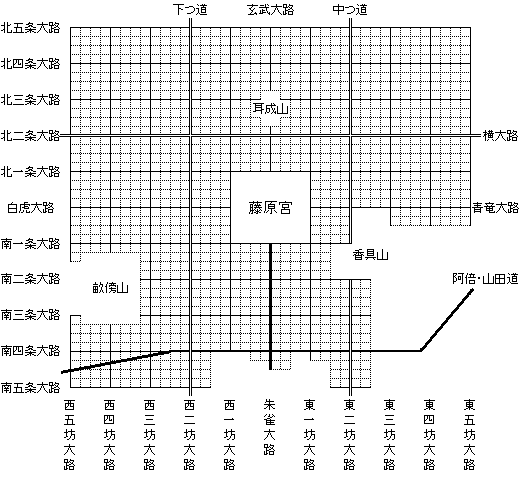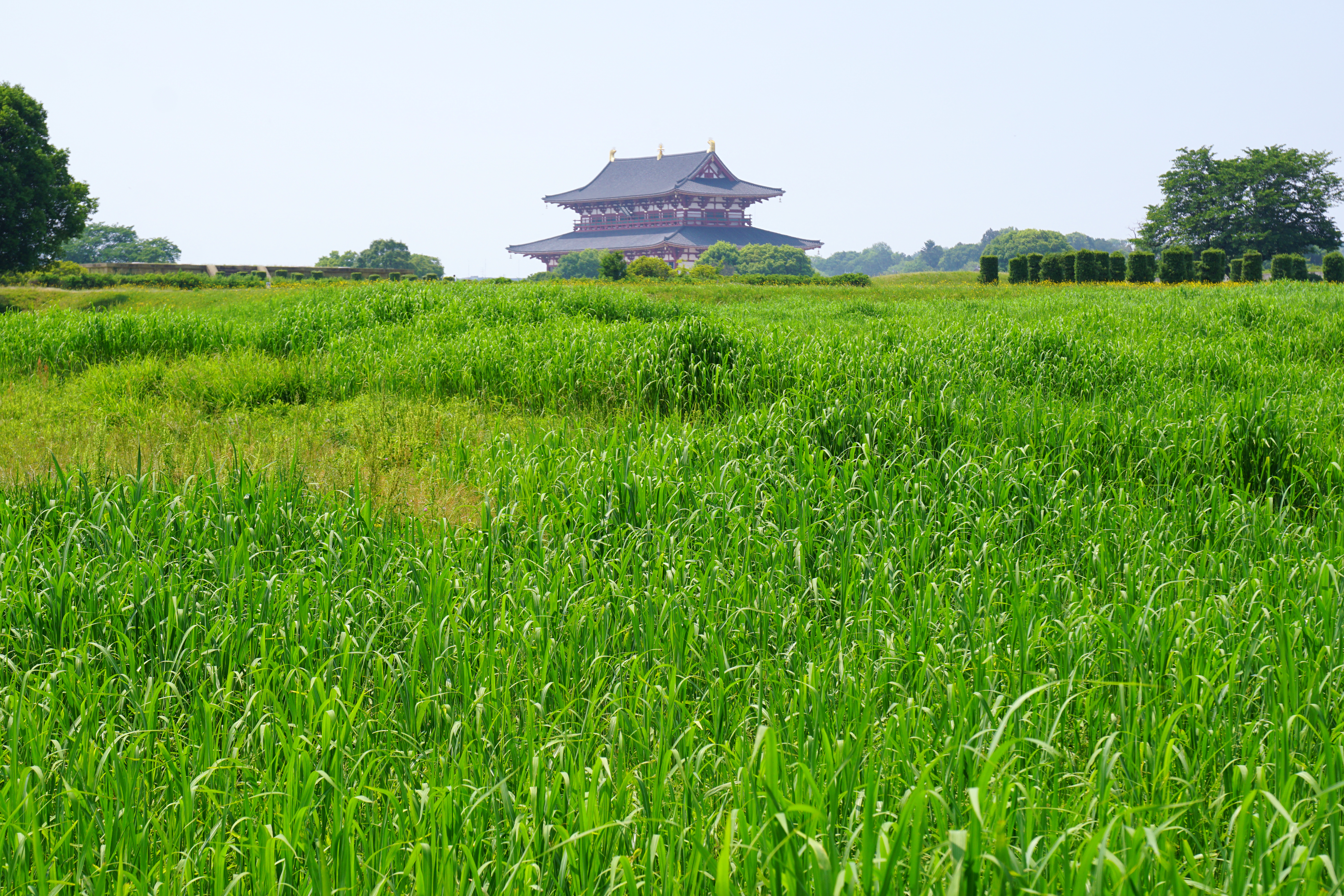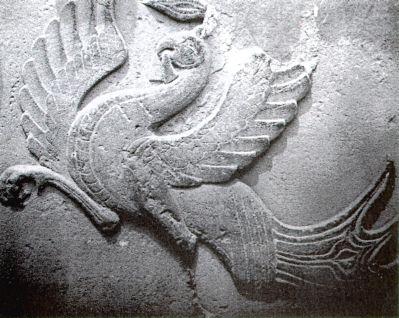|
Suzaku Avenue
is the name given to the central avenue leading to the Imperial Palace from the south in Japanese capitals. Traditionally the Imperial palace complex faces south, whilst Suzaku Avenue leads directly away from the main gate. Cities were often based on a traditional Chinese grid pattern. Suzaku Avenue was typically the central road within the city grid, and as a result, the widest. Fujiwara-kyō, Heijō-kyō, and Heian-kyō had their own Suzaku Avenue. The word " Suzaku" refers to the Guardian God of the South, who was said to appear in the form of a bird. Heian-kyō In Heian-kyō, present-day Kyoto, the Rajōmon (Rajōmon, Raseimon) was at the southern end of Suzaku Avenue, flanked on the east by the temple of Tō-ji, and on the west by the temple of Sai-ji, whilst at the northern end there was the main gate Suzakumon of Heian Palace. Of these, only Tō-ji remains. Over time Suzaku Avenue stopped being the central street, due to the gradual abandonment of the west of the city. ... [...More Info...] [...Related Items...] OR: [Wikipedia] [Google] [Baidu] |
Japan
Japan ( ja, 日本, or , and formally , ''Nihonkoku'') is an island country in East Asia. It is situated in the northwest Pacific Ocean, and is bordered on the west by the Sea of Japan, while extending from the Sea of Okhotsk in the north toward the East China Sea, Philippine Sea, and Taiwan in the south. Japan is a part of the Ring of Fire, and spans Japanese archipelago, an archipelago of List of islands of Japan, 6852 islands covering ; the five main islands are Hokkaido, Honshu (the "mainland"), Shikoku, Kyushu, and Okinawa Island, Okinawa. Tokyo is the Capital of Japan, nation's capital and largest city, followed by Yokohama, Osaka, Nagoya, Sapporo, Fukuoka, Kobe, and Kyoto. Japan is the List of countries and dependencies by population, eleventh most populous country in the world, as well as one of the List of countries and dependencies by population density, most densely populated and Urbanization by country, urbanized. About three-fourths of Geography of Japan, the c ... [...More Info...] [...Related Items...] OR: [Wikipedia] [Google] [Baidu] |
Fujiwara-kyō
was the Imperial capital of Japan for sixteen years, between 694 and 710. It was located in Yamato Province (present-day Kashihara in Nara Prefecture), having been moved from nearby Asuka. However, the name Fujiwara-kyō was never used in the '' Nihon Shoki''. During those times it was recorded as Aramashi-kyō (新益京). As of 2006, ongoing excavations have revealed construction on the site of Fujiwara-kyō as early as 682, near the end of the reign of Emperor Tenmu. With a brief halt upon Emperor Tenmu's death, construction resumed under Empress Jitō, who officially moved the capital in 694. Fujiwara-kyō remained the capital for the reigns of Emperor Monmu and Empress Genmei, but in 710 the Imperial court moved to the Heijō Palace in Nara, beginning the Nara period. History Fujiwara was Japan's first capital built in a grid pattern on the Chinese model (条坊制 ''jōbō-sei''); recent investigation has revealed that the city covered an area of roughly 5 km, ... [...More Info...] [...Related Items...] OR: [Wikipedia] [Google] [Baidu] |
Heijō-kyō
was the Capital of Japan during most of the Nara period, from 710 to 740 and again from 745 to 784. The imperial palace is a listed UNESCO World Heritage together with other places in the city of Nara (cf. Historic Monuments of Ancient Nara). Empress Genmei ordered the Imperial capital moved from Fujiwara-kyō to Heijō-kyō in 708, and the move to Heijō-kyō was complete in 710. Heijō-kyō was modeled after Chang'an, the capital of Tang-dynasty China, although Heijō-kyō lacked walls. In the city, merchants and traders from China, Korea and India introduced various foreign cultures to Heijō-kyō through the Silk Road. As a result, Heijō-kyō flourished as Japan's first international and political capital, with a peak population of between 50,000 and 100,000. The overall form of the city was an irregular rectangle, and the area of city is more than 25 km2. Architecture In the area of Heijō-kyō, there are ancient Buddhist temples, and some temples are als ... [...More Info...] [...Related Items...] OR: [Wikipedia] [Google] [Baidu] |
Heian-kyō
Heian-kyō was one of several former names for the city now known as Kyoto. It was the official capital of Japan for over one thousand years, from 794 to 1868 with an interruption in 1180. Emperor Kanmu established it as the capital in 794, moving the Imperial Court there from nearby Nagaoka-kyō at the recommendation of his advisor Wake no Kiyomaro and marking the beginning of the Heian period of Japanese history. According to modern scholarship, the city is thought to have been modelled after the urban planning for the Tang dynasty Chinese capital of Chang'an (modern-day Xi'an).. It remained the chief political center until 1185, when the samurai Minamoto clan defeated the Taira clan in the Genpei War, moving administration of national affairs to Kamakura and establishing the Kamakura shogunate. Though political power would be wielded by the samurai class over the course of three different shogunates, Heian remained the site of the Imperial Court and seat of Imperial ... [...More Info...] [...Related Items...] OR: [Wikipedia] [Google] [Baidu] |
Vermilion Bird
The Vermilion Bird ( zh, c=朱雀, p=Zhūquè) is one of the Four Symbols of the Chinese constellations Traditional Chinese astronomy has a system of dividing the celestial sphere into asterisms or constellations, known as "officials" ( Chinese ''xīng guān''). The Chinese asterisms are generally smaller than the constellations of Hellenisti .... According to Wu Xing, the Taoism, Taoist five elemental system, it represents the Fire (Wu Xing), Fire element, the direction south, and the season summer correspondingly. Thus it is sometimes called the Vermilion Bird of the South (Chinese language, Chinese: , ). It is described as a red Phoenix (mythology), bird that resembles a pheasant with a five-colored plumage and is perpetually covered in flames. It is known as Suzaku in Japanese, Jujak in Korean and Chu Tước in Vietnamese. It is often mistaken for the Fenghuang due to similarities in appearance, but the two are different creatures. The Fenghuang is a legendary rule ... [...More Info...] [...Related Items...] OR: [Wikipedia] [Google] [Baidu] |
Kyoto
Kyoto (; Japanese language, Japanese: , ''Kyōto'' ), officially , is the capital city of Kyoto Prefecture in Japan. Located in the Kansai region on the island of Honshu, Kyoto forms a part of the Keihanshin, Keihanshin metropolitan area along with Osaka and Kobe. , the city had a population of 1.46 million. The city is the cultural anchor of a substantially larger metropolitan area known as Greater Kyoto, a metropolitan statistical area (MSA) home to a census-estimated 3.8 million people. Kyoto is one of the oldest municipalities in Japan, having been chosen in 794 as the new seat of Japan's imperial court by Emperor Kanmu. The original city, named Heian-kyō, was arranged in accordance with traditional Chinese feng shui following the model of the ancient Chinese capital of Chang'an/Luoyang. The emperors of Japan ruled from Kyoto in the following eleven centuries until 1869. It was the scene of several key events of the Muromachi period, Sengoku period, and the Boshin War, such a ... [...More Info...] [...Related Items...] OR: [Wikipedia] [Google] [Baidu] |
Rajōmon
, also called , was the gate built at the southern end of the monumental Suzaku Avenue in the ancient Japanese cities of Heijō-kyō (Nara) and Heian-kyō (Kyoto), in accordance with the Chinese grid-patterned city layout. At the other far north-end of Suzaku Avenue, one would reach the Suzakumon Gate, the main entrance to the palace zone. , the southern end of Suzaku Avenue and the possible remainder of the equivalent gate in Fujiwara-kyō (Kashihara) are yet to be discovered. Name The gate's name in modern Japanese is ''Rajōmon''. ''Rajō'' (羅城) refers to city walls and ''mon'' (門) means "gate," so ''Rajōmon'' signifies the main city gate. Originally, this gate was known as ''Raseimon'' or ''Raiseimon'', using alternate readings for the kanji in the name. The name ''Rashōmon'', using the kanji 羅生門 (which can also be read ''Raseimon''), was popularized by a noh play Rashōmon (c.1420) written by Kanze Nobumitsu (1435–1516). The modern name, ''Rajōmon'' ... [...More Info...] [...Related Items...] OR: [Wikipedia] [Google] [Baidu] |
Tō-ji
, also known as is a Shingon Buddhist temple in the Minami-ku ward of Kyoto, Japan. Founded in 796, it was one of the only three Buddhist temples allowed in the city at the time it became the capital of Japan. As such it has a long history, housing treasures and documents from the early Heian period and the Tang dynasty, and with buildings in its complex covering the Kamakura, Muromachi, Momoyama, and Edo periods. Five of these buildings have been designated National Treasures in two different categories: the Lotus Flower Gate (''rengemon''), the Miei Hall (''mieidō''), the Golden Hall (''kondō'') and the five-storied Pagoda (''gojūnotō'') ( temple buildings) and the Kanchiin Guest Hall (''kanchiin kyakuden'') ( residences). Tō-ji was designated a UNESCO World Heritage Site in 1994, as part of the Historic Monuments of Ancient Kyoto. History Tō-ji was founded in the early Heian period. The temple dates from 796, two years after the capital moved to Heian-kyō. Toget ... [...More Info...] [...Related Items...] OR: [Wikipedia] [Google] [Baidu] |
Sai-ji
or the ''West Temple'' was one of the two large Buddhist temples established in Kyoto, Japan. History Sai-ji was founded in the early Heian period.Ponsonby-Fane, Richard. (1956). ''Kyoto: The Old Capital of Japan, 794-1869,'' p. 111. The temple dates from 796, two years after the capital moved to Heian-kyō. Sai-ji was established together with the other temple, Tō-ji (the ''East Temple''). Each occupied a square site of approximately 300 m by 300 m situated symmetrically on both sides of the Suzaku Avenue (Suzaku-ōji, present-day Senbon-dōri), just north of the great Rashōmon gate along the southern edge of the city. While Tō-ji has survived (albeit rebuilt) into modern times, Sai-ji was burnt in 990 and 1233, then abandoned and never rebuilt. The two temples (together with Shingon-in in the imperial palace) were the only Buddhist institutions allowed in the capital at the time it was established. This policy was introduced by Emperor Kanmu in order to curb t ... [...More Info...] [...Related Items...] OR: [Wikipedia] [Google] [Baidu] |
Suzakumon
The was the main gate built in the center of the south end of the imperial palaces in the Japanese ancient capitals of Fujiwara-kyō ( Kashihara), Heijō-kyō (Nara), and later Heian-kyō ( Kyoto). The placement followed the ancient Chinese palace model requirements at the time, where , the Vermilion Bird was the Guardian of the South. (''See Four Symbols for more.'') It was said to be the site where foreign dignitaries were received by the Emperor. All of them were destroyed centuries ago along with the old imperial residences. Nara Suzakumon In 1993, it was decided that the gate of Nara would be reconstructed. It proved extremely difficult to work out what Suzakumon had looked like, as there were no surviving structural remnants. A conjectural model was developed, based on comparable architecture elsewhere, and the new gate was constructed from a mixture of traditional building materials ( cypress wood and tiles) and concrete, in order to resist earthquakes. The reconstruc ... [...More Info...] [...Related Items...] OR: [Wikipedia] [Google] [Baidu] |





